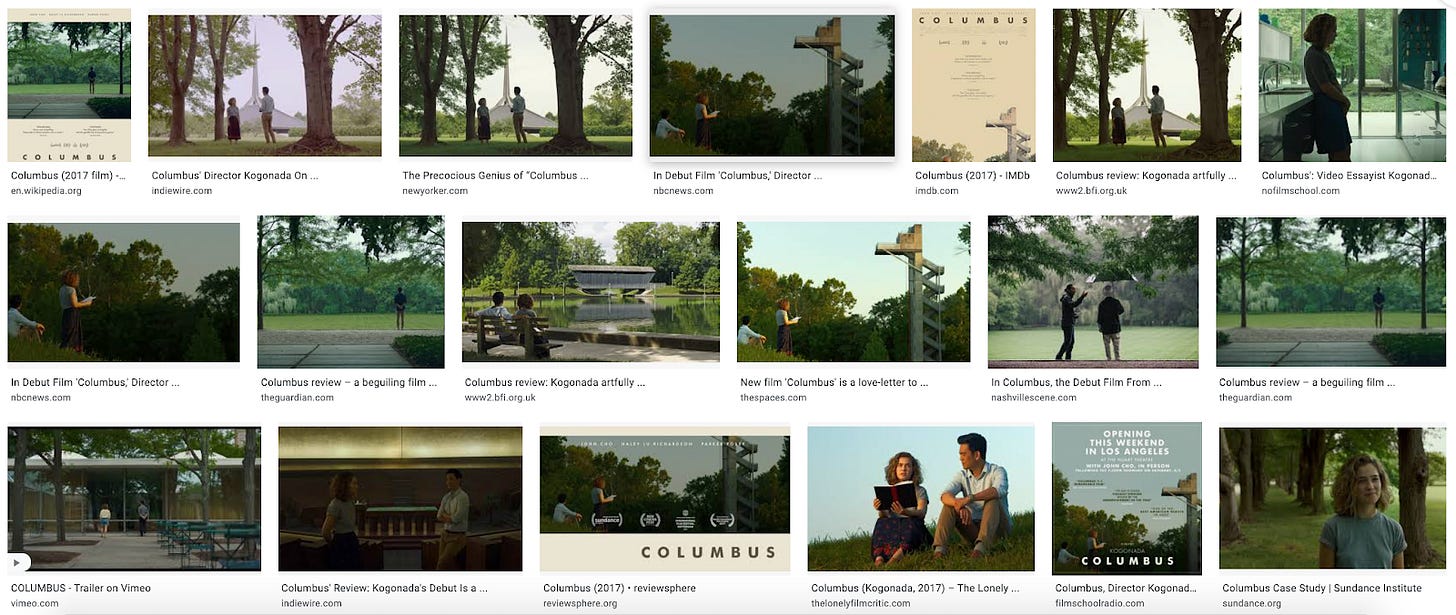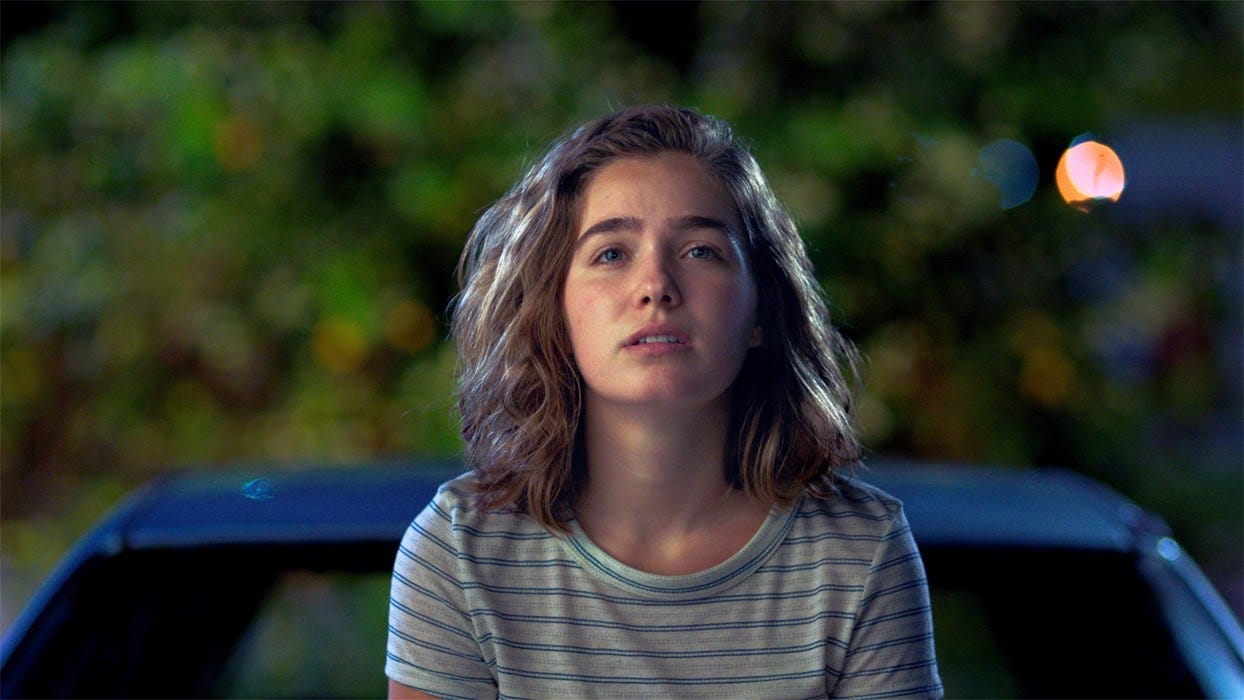#33: Main character syndrome
Art imitates life imitates art...
Maybe Baby is a free Sunday newsletter. If you love it, consider supporting it financially. For $5/mo, you’ll gain access to my monthly five-part advice column, Dear Baby, as well as my Tuesday weekly podcast. Thank you! (You’ll never see an ad either way.)
Good morning!
I feel substantially less depressed this week, and it’s wild how much energy is restored when I’m not wasting all of it on trying to manage my mind. I cleaned out my inbox? Anyway, this newsletter isn’t about that, but this is a reminder that if you’re in that place, the dread you’re feeling isn’t necessarily “the truth,” and you’ll probably see things differently one day, maybe even when everything objectively still sucks, and you’ll be better equipped to handle it.
Art and artifice
A few weeks ago, I asked my Instagram followers for movie suggestions in the calming, ASMR-inducing vein of Phantom Thread and Portrait of a Lady on Fire. Almost immediately, several people recommended Columbus, a 2017 drama about architecture; the directorial debut of beloved South-Korean-American filmmaker Kogonada. I was sold on the Google Image search results alone:
As promised, Columbus was cerebral and plodding, seemingly more concerned with evoking a serene, melancholic mood than telling a story from start to finish. Early on, the protagonist, Casey, a 20ish-year-old architecture enthusiast played by Haley Lu Richardson, observes that a building is “asymmetrical, but balanced.” This principle is carried through the whole movie—especially aesthetically, but emotionally, too. It’s clear the director is himself obsessed with architecture; he holds shots of structures so long you’re forced to reckon with how they make you feel. Some scenes unfold without sound, or are overlaid with conversations that aren’t taking place at the same time, creating an anachronistic atmosphere that challenges linear storytelling. I really liked the movie (obviously), there was just one little thing I couldn’t get past, and I’ve been thinking about it for days.
The narrative framework of Columbus, no spoilers, is that Casey is getting to know a man she’s just met by showing him all her favorite buildings in Columbus, Indiana, a small town that happens to have a high concentration of famous Modernist architecture. The man is named Jin (John Cho), and he’s an English translator who’s just traveled to Columbus from Seoul upon learning that his father, a renowned architecture scholar, is dying. Casey loves architecture; Jin, having a complicated relationship with his father, is disillusioned by it, and therein lies their central tension. The tour takes place over many days—each of them managing to duck away at random intervals to carry on intimate, pause-laden conversations in front of beautiful structures: Casey often turned toward the building, Jin often turned toward Casey. He wants to know “what moves her, what really moves her”; she doesn’t know she’s beautiful, etc. It is the kind of scenario about which, if it actually happened to you, you’d think to yourself, this is like something out of a movie. More than that, you might be manipulating it to be so.
This is my small gripe with the plot of Columbus, or perhaps with the way modern dramas are often written: They rarely account for the fact that many people’s thoughts and behaviors today are heavily influenced by what they’ve seen in the movies. Like the way that, especially during a period of courting, a young person is most likely performing their personality rather than simply existing as themselves. But Casey and Jin are presented as completely earnest, neither romantic about nor even aware of their choice to tour the city in the most sensual way imaginable. You never see them have to give an awkward wave goodbye, or coordinate logistics. Instead they live inside a dreamy montage that relies on its own containment to be convincing; the kind you might try, but ultimately fail, to recreate in real life. I’m not sure Kogonada would care about this criticism at all—I think his approach to this story had aims beyond examining the specific and complicated interiority of these characters—but this consciousness gap consistently took me out of the movie.
A few weeks ago, I saw a TikTok of a teenage boy wandering around a backyard at dusk, looking wistfully at the sky, pausing occasionally to sit with his knees pulled up to his chest. It was scored with cinematic music and captioned something like, “When you break off from your friend group to be the main character by yourself for a while…” I can’t for the life of me find it now, but it’s somehow become implanted in my long-term memory as the perfect self-own. I later learned this was part of a broader “I’m the main character” TikTok meme, in which (American?) zoomers admit to thinking of themselves as the main character among their friends, schools, or neighborhoods. Per knowyourmeme.com, this was the first that inspired the rest:
There is now a cringey subset of this meme that is more earnest—photo and video montages featuring the creator set to an audio of a girl saying, “You have to start thinking of yourself as the main character, because if you don’t, life will continue to pass you by.” These fall flat for me because they merely reinforce the my-life-is-a-movie self-mythology most of us are already doing online. (One critique of these montages became a meme itself: “You have to stop.”) But the videos that poke fun at themselves for this narcissistic tendency feel more confessional and funny. A girl admitting to dancing in a pseudo-care-free way in front of her window in a cute outfit; a kid confessing to looking sad on a train to seem interesting. They’re admitting the thing you’re not supposed to admit, which is that a lot of public life is a performance, and that much of what reflects well on you—particularly as it translates online—has been engineered to do so. I’d like to think this is less true as you get older and less self-conscious, but I think social media has a way of arresting that particular development.
In his seminal work Simulation and Simulacra (1981), the philosopher Jean Baudrillard argued that modern life was becoming increasingly iterative and alienated from that which is “real.” He believed that postmodern reality had become nothing more than a convoluted system of symbols and signs—culture, media, consumerism: He called it hyperreality. And we, as participants, instead of recognizing our motivations as endlessly distorted responses to this simulation, see our desires as reasonable responses to our actual reality: as truth. As a result, true meaning is obfuscated—infinitely mutable, and therefore rendered meaningless, leaving all of us in a state of inexplicable melancholy. (No surprise that his work inspired The Matrix.)
It’s definitely too lofty to call the “I’m the main character” meme a glitch in the matrix of social media—after all, its very effect undermines the joke—but it does attempt to at least acknowledge the artifice, if not subvert it. This seems more likely to happen on TikTok than, say, Instagram. The focus on speed and amateurishness in the former means it has an incidental way of capturing authenticity. As Marlowe Granados writes in The Baffler, “What is more clear is that TikTok shifts the visual dialogue away from the perfectly manicured aesthetic of Instagram, which is known more for its users’ aspirational, flawless image curation. TikTok instead privileges on-screen presence, performance, and bite-sized narrative.” Granados points out that creators are often filming in messy rooms and in stained clothes—the window-dressing of the video less important than what transpires within it. This is why, in the process of consuming TikToks, you begin to get a real sense for how people live, whether the creators intended to share that information or not.
Of course, TikTok merely upholds different values than Instagram, not necessarily more noble ones. And with its unfathomable growth, mysterious algorithm, and dubious ethics, the idea that it represents a departure from hyperreality is comically absurd. But what I appreciate about the main character meme and its seemingly widespread resonance is that it reveals just how many layers of reality we’re wading through: not just the one between who we are and who we’re pretending to be, but who we’re pretending to be and who that person might be in a movie, and how that character might be seen by other characters, and what that says about us, and how we might express that in cyberspace, where we are asked to perform ourselves so that we might be better known—but known as who, and to whom, and why? It’s a total mindfuck, a perfect encapsulation of the way performance has itself become truth, and nothing really means anything anymore.
I’m drawn to art that attempts to grapple with this insanity. And I don’t just mean art that references social media in a literal sense a la Ingrid Goes West, but the kind that acknowledges the infinitely obscured human impulses that lead us to behave (and perform) the way we do, online and elsewhere—like say, Michaela Coel’s I May Destroy You, or the cringey characters of comedian Megan Stalter, or Kazuo Ishiguro’s Never Let Me Go, or Toni Collette in Wanderlust, or possibly this poem by Alex Dimitrov, full of sweet delusions. Maybe this is why the earnest plot of Columbus didn’t pull me in, even though I enjoyed the movie on so many other levels. I’m less compelled by characters who aren’t self-conscious (and meta-self-conscious) in the way most people I know are, including myself. I’m hungry to see that cognitive kaleidoscope depicted in ways precious and grotesque. And it’s probably ironic, but also fitting, that the catalyst for all this was TikTok, the apex of art and artifice.
1. This week’s Small Good Things is this massive velvet chair shaped like a pig. Not the article (although it’s funny and good), but the chair itself, which I’m now certain I need in order to have a fulfilling life.
2. This New York Times interview with Kurt Russell and Goldie Hawn on their first movie together since Overboard, which I was contractually obligated to read having grown up on Overboard. As the teens would say, they absolutely pass the vibe check. Are teens still saying that though?
3. Phoebe’s new EP, Copycat Killer, which is just four different (and good!) versions of songs from her recent album, Punisher.
4. “The Downward Spiral,” a perfect and weird little essay by Dean Kissick for Spike Art Magazine that I immediately sent to two people when I finished it.
“I watched a friend dancing around for her Instagram dressed as a happy-go-lucky candy cane, and it was very unconvincing. I watched another friend using a filter that stuck a knife through her head, blood spurting out, staring dead-eyed at her own image, hypnotised, totally self-absorbed, and that felt very convincing, and authentically her. Authenticity is an attractive quality in a person, still.”
5. A brief Wikipedia rabbithole starting with affective forecasting—which, as mentioned by a recent Maybe Baby commenter, is the human tendency to over- or underestimate our future emotions—which led me to reading about all the reasons we make bad decisions, like the anchoring bias, the empathy gap, and the impact bias.
6. “The Pandemic Safety Rule That Really Matters,” a straightforward piece in The Atlantic by Rachel Gutman about the Covid guideline to rule them all: Don’t spend time inside with people outside your household.
7. This TikTok, which confirmed my algorithm thinks I’m into girls. And it’s definitely plausible since I watched it 10 times, but I might just want her haircut? TBD.
(Lol @ all the girls in the comments saying “I have a boyfriend I have a boyfriend I have boyfriend.”)
8. “Stuck in the Suburbs,” an op-ed by Marie Solis for The Baffler about the mistake of assuming women necessarily represent a political cohort.
“Women are hardly united in their interests, politically or materially. Other facets of their identity—their class position, their religion, the job they have, how and where they grew up—might more readily determine the shape of their lives and the political beliefs they endorse as a result. So it should be obvious that women can be mad about attacks on abortion rights or they can be mad about abortion rights themselves; they can be angry about sexual assault or outraged by the ease with which other women seem to claim victim status. They might be incandescent that the president allowed a pandemic to claim hundreds of thousands of lives, or they may be incensed that they had to wear a mask to the grocery store. Women’s rage can be righteous and noble, but, as Intercept contributor Natasha Lennard once put it, it can also be ‘reactionary and fucking racist.’ It can, of course, inspire a woman to vote for Trump.”
9. Pure Luck (1991), my favorite childhood movie starring Martin Short and Danny Glover, which is just as outrageous as I remembered, and possibly more incredible?
10. “The Pandemic Clarified Who the Kardashians Really Are,” a satisfying (but overly optimistic about their impending irrelevance, I think) piece by Spencer Kornhaber for The Atlantic.
“Kim clearly believed that her family’s old formula still worked and that she could find a way to balance conscientiousness and abandon, just-like-youness and not-at-all-like-youness, with her party pictures. But the ensuing scorn shows that her calculation was off: The pandemic has been so deeply and universally disruptive that flaunting one’s escape from it triggers more disgust than fascination.”
11. Cazzie David’s much maligned piece in The Cut about how sometimes she’s “too full to fuck,” which garnered accusations of nepotism (she’s Larry David’s daughter). I’m actually bringing pop culture experts Avi and Harling BACK on the pod to discuss this one on Tuesday don’t miss it!!
12. “The Parties Decide,” an opinion piece by Adam Kotsko in The Baffler about why electoral politics don’t seem to change despite everyone knowing they’re undemocratic.
“A system in which people could vote for an option that sincerely reflected their preference without perversely benefiting the opposite cause would be a more just and rational one. It is not clear how we can get there from here, but one step is surely to recognize that such a system would be contrary to the interests of the current elites who hold the balance of power in the Democratic Party.”
13. “Something Has to Change” by Japanese House, which made me think, damn, it really does…
14. 1g of psychedelic mushrooms, after which I walked around a small body of water and heard the above song. I then proceeded to make the most colorful stoner drawing of my life, which I’m convinced healed something inside of me.
15. “TIMELAPSE OF THE FUTURE: Journey to the end of time,” an insane 30-minute visualization my brother sent me of what might happen to the universe over the next trillions and trillions of years, according to what we currently know. Smoke a j first?
Reminder that next week is my five-part Q&A column, Dear Baby. If you’d like to read it, you can become a paying subscriber here. If you’d like to ask me a question, you can do that here!
Thanks so much for reading,
Haley
This month a portion of subscriber proceeds will be redistributed to Palante Harlem Inc, a New York-based nonprofit working to reduce poverty, end tenant exploitation, and advocate for safe housing in Harlem.
Subscribe • Request a free subscription • Ask Dear Baby a question • Gift a subscription










I posted my comment then read the others. I just wanted to say this is an amazing comments section omg
"This is my small gripe with the plot of Columbus, or perhaps with the way modern dramas are often written: They rarely account for the fact that many people’s thoughts and behaviors today are heavily influenced by what they’ve seen in the movies."
^^This reminds me of this 2005 piece by Mark Grief in n+1: https://nplusonemag.com/issue-3/reviews/reality-reality-television/
He writes: "THE REALITY OF reality television is that it is the one place that, first, shows our fellow citizens to us and, then, shows that they have been changed by television. This reality is the unacknowledged truth that drama cannot, and will not, show you. A problem of dramatic television, separate from what the corrupt characters say and do, is that it shows people who live as if they were not being shaped by television. On this point it profoundly fails to capture our reality. "
I read the Grief essay like 100 years ago but I think about this point all the time!